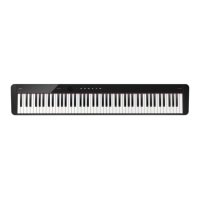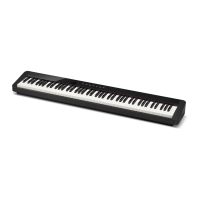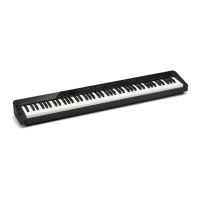Do you have a question about the Casio Privia PX-5S and is the answer not in the manual?
Step-by-step guide on how to modify built-in tones.
Instructions for giving a custom name to an edited tone.
Detailed parameters for editing melody tones, including envelopes and filters.
Parameters specific to editing drum tones, such as pitch and filter settings.
Overview of DSP, System, and Master effects available for sound enhancement.
Specific parameters for Digital Signal Processor effects like Equalizer and Compressor.
Master effects parameters for Compressor and Equalizer applied to the final output.
Step-by-step process for editing arpeggio types, notes, velocity, and control data.
Information on recording musical phrases and operations into memory.
How to select and modify banks and stage setup numbers.
Details on parameters that can be configured within a stage setup, including zones, mixer, tones, and controllers.
Explanation of MIDI and its application for connecting to other devices.
Step-by-step guide on how to modify built-in tones.
Instructions for giving a custom name to an edited tone.
Detailed parameters for editing melody tones, including envelopes and filters.
Parameters specific to editing drum tones, such as pitch and filter settings.
Overview of DSP, System, and Master effects available for sound enhancement.
Specific parameters for Digital Signal Processor effects like Equalizer and Compressor.
Master effects parameters for Compressor and Equalizer applied to the final output.
Step-by-step process for editing arpeggio types, notes, velocity, and control data.
Information on recording musical phrases and operations into memory.
How to select and modify banks and stage setup numbers.
Details on parameters that can be configured within a stage setup, including zones, mixer, tones, and controllers.
Explanation of MIDI and its application for connecting to other devices.
| Keyboard | 88 keys, Tri-sensor Scaled Hammer Action Keyboard II |
|---|---|
| Sound Source | Multi-dimensional Morphing AiR |
| Polyphony | 256 notes |
| Arpeggiator | Yes |
| Weight | 11.1 kg (24.5 lbs) |
| Speakers | No built-in speakers |
| Touch Sensitivity | 3 sensitivity levels, off |
| Display | LCD with backlight |
| Effects | Reverb, Chorus, DSP |
| Power Supply | AC Adapter AD-A12150LW |
| Connectivity | USB, MIDI |
| Audio Recorder | Yes |
| USB | Yes |
| Pedal Input | 2 (Damper, Assignable) |
| Recorder | MIDI recorder |











